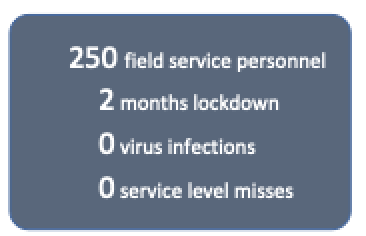
By Alan Ifould, Global Market Sector Manager, Semiconductor Services, Edwards Ltd.
The COVID-19 pandemic remains front and centre of everyone’s mind as we continue to learn about its human and economic impacts. There are glimmers of light as the statistics turn positive in the regions where stringent measures were first adopted. We are collectively discovering what works and what does not work to protect our people while maintaining business activity. We are seeing large scale adoption of tele-technologies, but how does that apply to the semiconductor industry which still relies on human action in so many parts of its value chain?
Continuity in an “Essential Business”
In a recent blog[1] the Semiconductor Industry Association (SIA) successfully made the case to global governments that the Semiconductor Industry is an “essential business” and should remain operational. Fabs remained largely open for business in China and South Korea with appropriate controls in place to safeguard employees and maintain business continuity.
Edwards has first-hand experience of this. In China, Edwards runs a team of around 250 service personnel supporting our semiconductor customers. They work across 80 different sites in 31 cities. As the China lockdown started in late January, we adopted strict personnel safeguarding practices in consultation with our customers. Our support model switched from on-site to an on-call/remote model. We adopted strict PPE, hygiene and social distancing protocols. And we established a daily communication plan with our teams and with our customers to share virus control information and to prioritise essential tasks. The result? As of the end of April, we had zero virus infections on our team. We had no major service level misses at our customers. And our teams are now back on-site as fabs return to near-normal operation.

But there is more to business continuity. McKinsey[2] advocates common-sense short-term business continuity actions: protect employees, screen and safeguard the supply chain, maintain financial health and adapt marketing. These will provide the foundation from which recovery is built. Today, the message we receive from our customers is very much one of continued investment for the longer term. Our challenge is to enable that in parallel with probable restrictions on supply chain and personnel movements.
Safeguarding the Supply Chain and Managing Costs
While we understand how to protect employees, safeguarding the supply chain is something the industry is still exploring. The global semiconductor supply chain is complex. As different regions emerge from severe short-term restrictions , perturbations will likely ripple through the supply chain. Labour and logistics constraints may impact supply chain capacity and parts availability. We will still need to provide expert support at the site while respecting restrictions on personnel movements.
So how do we mitigate these impacts? Put simply, planning and avoidance. Down events are always disruptive and have been one of the core drivers behind the rapid adoption of Industrie 4.0 (or Smart Manufacturing). The negative impact of any disruption is magnified when the supply chain is already stressed. Limitations on the availability of personnel and restrictions on their movements increase response times. Logistical restrictions compromise parts availability. If a down event is unplanned, that further magnifies the negative impacts of constrained resources. Equipment wear or damage can be higher, requiring more parts. Response times become more urgent, increasing demands on restricted workforces. Costs increase.
The more the industry can plan (or even avoid) demands on resources, the better we will be able to safeguard short term supply chains, manage costs, and build for the long term.
The Role of Technology and our Solution
Service activity in the semiconductor subfab is workforce oriented. The safety and security of our teams and customers will always come first. Safety culture is strong at Edwards and throughout the semiconductor industry, and we have rapidly adopted the enhanced personnel protection practices required by the pandemic.
But can we do more to protect people and keep the essential semiconductor business running? We think yes. Information can still move freely. Data analytics can still generate valuable insights. By using information technology to harness remote knowledge and expertise, those insights can contribute to safer and more effective operations. How?
Safety first, as always. Remote analytics will warn when fault conditions are developing. Early corrective action may eliminate faults completely, negating the need for teams to visit the site. If a fault is not eliminated, action can at least be planned. Activities can be carried out with less time pressure and fewer people. With fewer people on site, personnel will realise the benefits of less travel and less contact.
Operational effectiveness. Planned operations require fewer resources, and the resources needed can be managed more effectively. This extends beyond the teams and materials needed on site to the resources required throughout the supply chain. A proactive, controlled down of a tool and its supporting vacuum systems can limit component wear or damage and reduce demand on the supply chain.
Supported by proactive, clear communication between service teams and the customer, equipment can be returned to service more quickly, and at lower cost, and, most importantly, with minimized risk to personnel.
The Path Forward
The semiconductor industry already embraces wide ranging use of data analytics and remote support in the cleanroom. It is time now to do the same in the sub-fab: using remote technology to bring the knowledge and expertise of skilled engineers into the subfab support model.
Our subfab operating models are already changing, powered by Smart Manufacturing initiatives [3]. We routinely use of remote resources during project setup. We deliver training remotely and use technology to gather self-assessments and ensure competence. We pre-configure analytical hardware and software away from the fab, minimizing the need for onsite expertise. And we mitigate start-up risks by testing virtual project planning against knowledge bases before execution.
Once operational we use new collaborative value-creation frameworks to drive reductions of risk and uncertainty. We share data from the sub-fab with our remote experts for analysis. Unlike the cleanroom, the sub-fab does not necessarily need real-time connections: weekly, secure file transfers are enough for effective analytics. We routinely communicate valuable insights back to customer operations teams for joint review. This sharing of domain expertise enables us to co-manage operational risks and the optimize sub-fab equipment service intervals.
Our Expertise Is Available to You
It will be months before we can imagine any return to “normal” as the world manages the impacts of COVID-19. But normal will no doubt look different. Working together we can continue to develop solutions that work today and build solid foundations for continued growth. Edwards remains committed to making our expertise accessible. We will learn rapidly what effective remote support models look like. That learning will help us shape the new normal.
[1] https://www.semiconductors.org/why-the-semiconductor-industry-must-stay-up-and-running-as-we-confront-covid-19/
[2] https://www.mckinsey.com/industries/advanced-electronics/our-insights/coronavirus-a-response-framework-for-advanced-industries-companies
[3] Edwards’ SubFab Smart Manufacturing E-book available to download https://www.edwardsinnovation.com/thought-leadership/operational-excellence/

